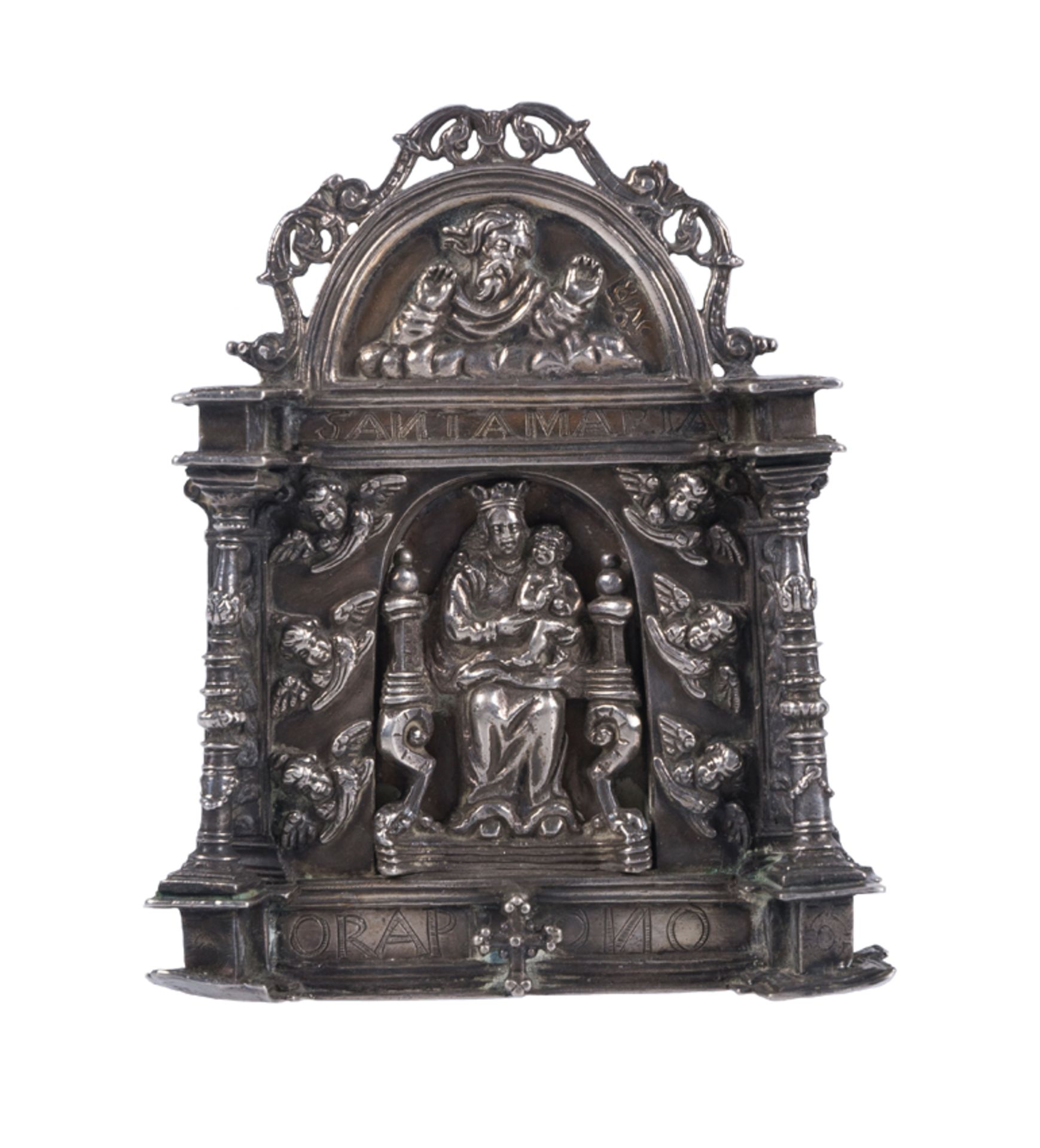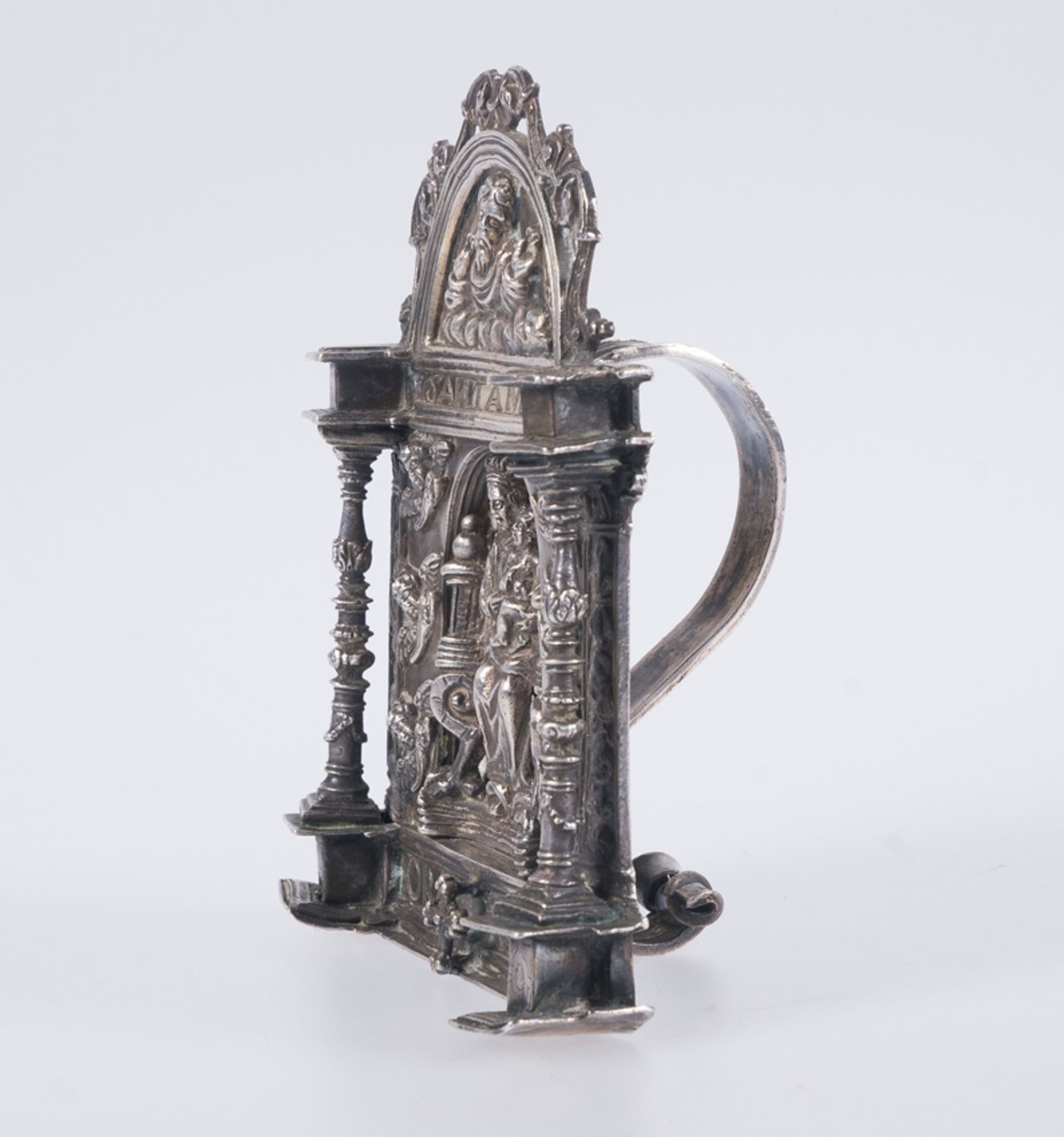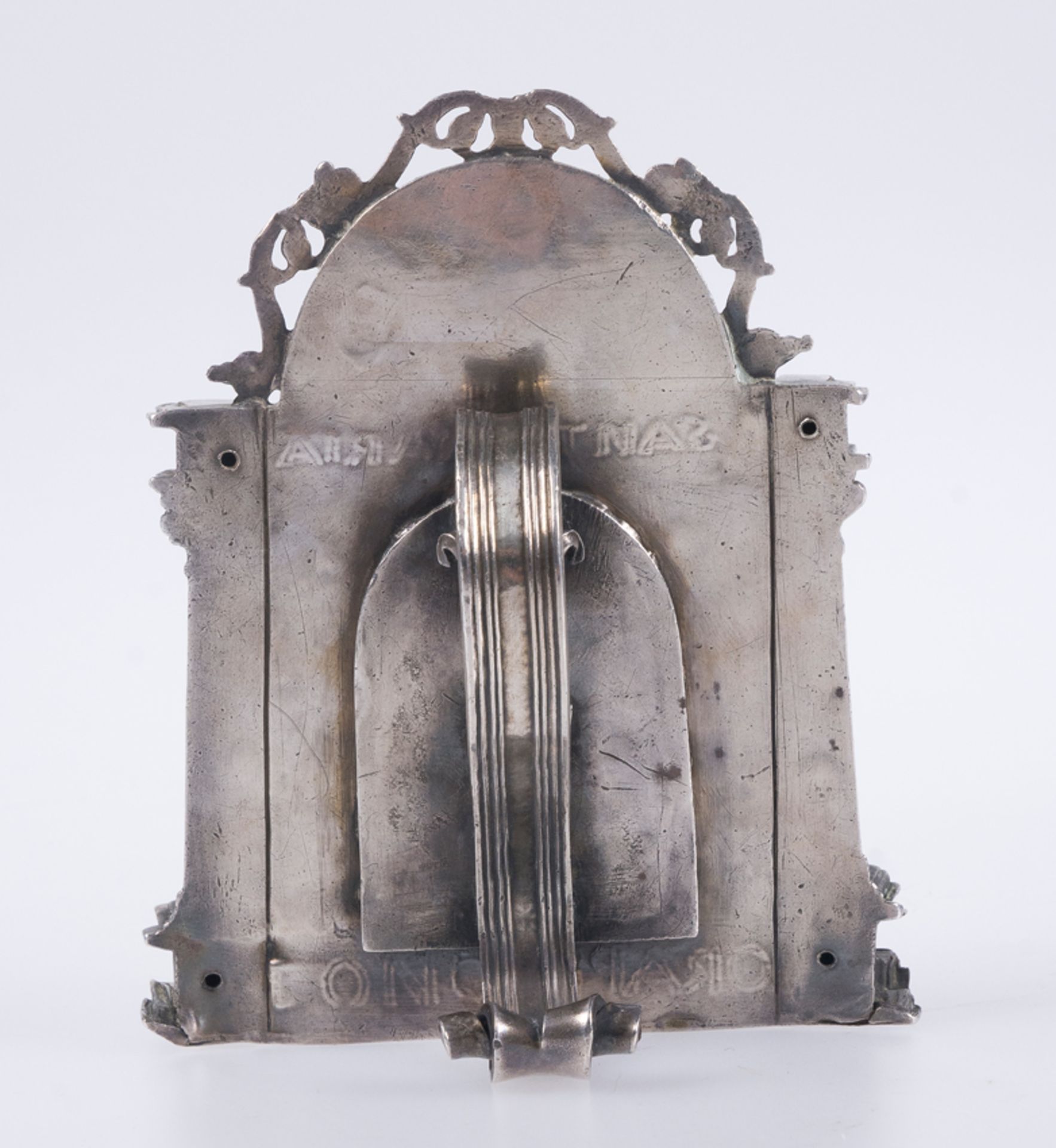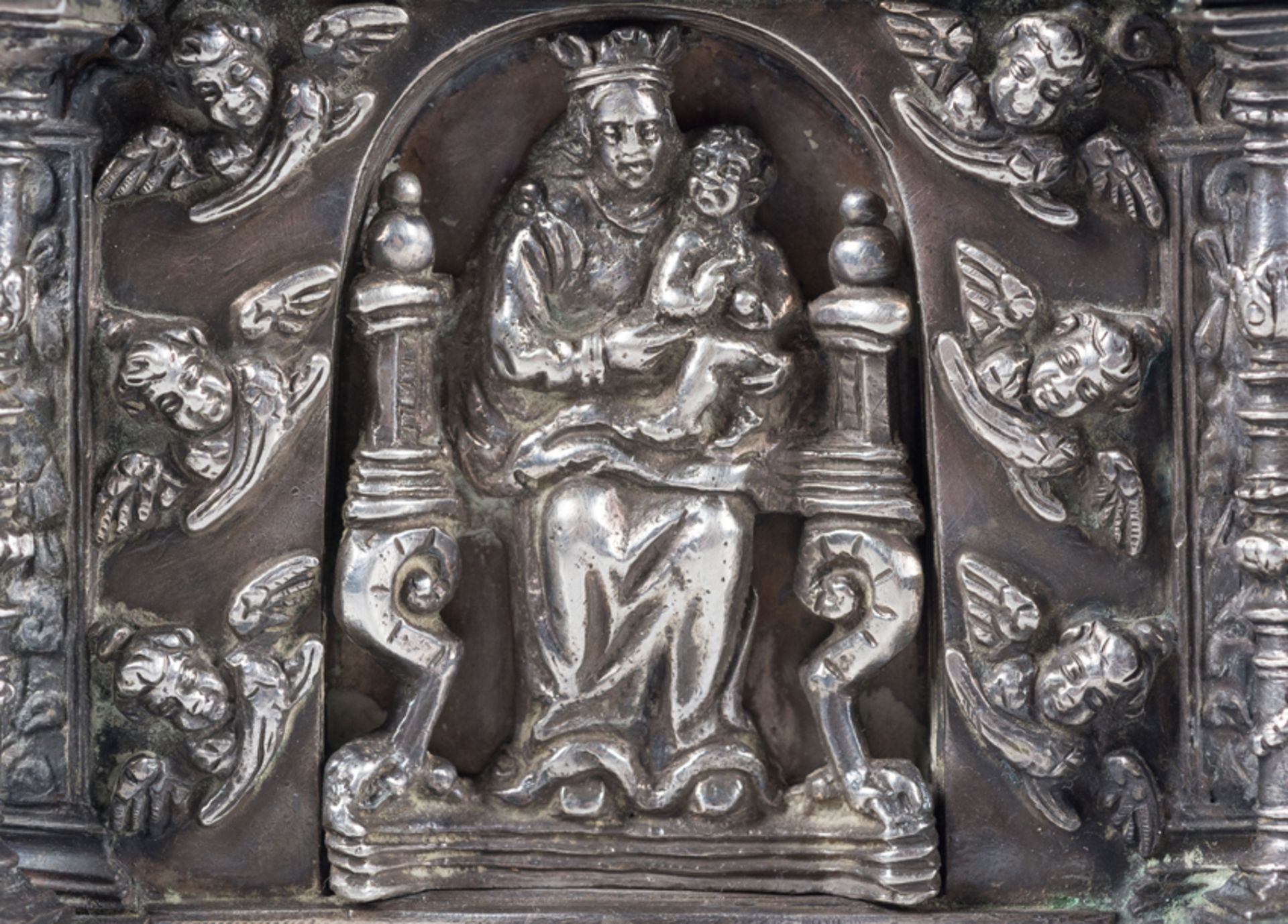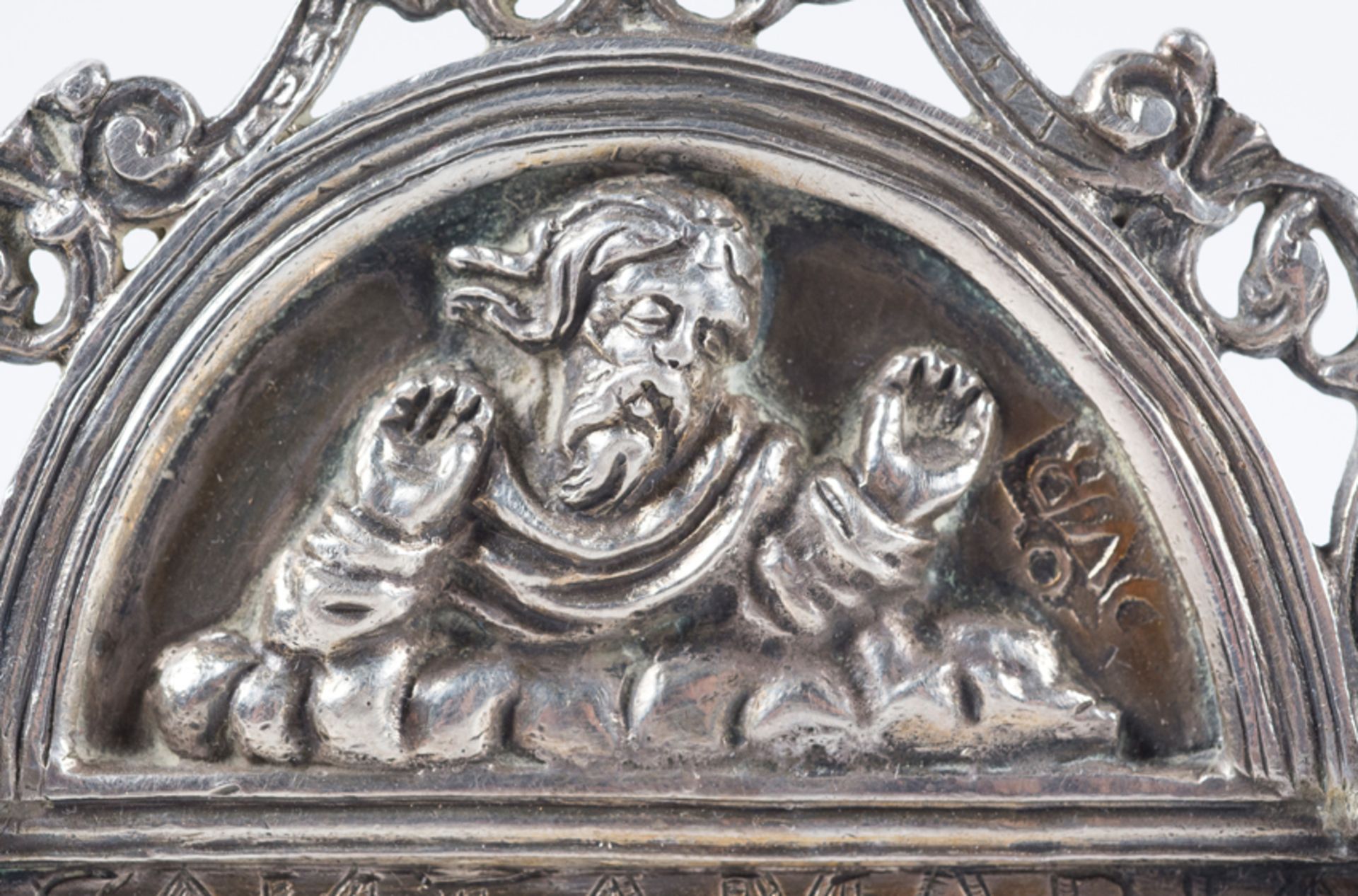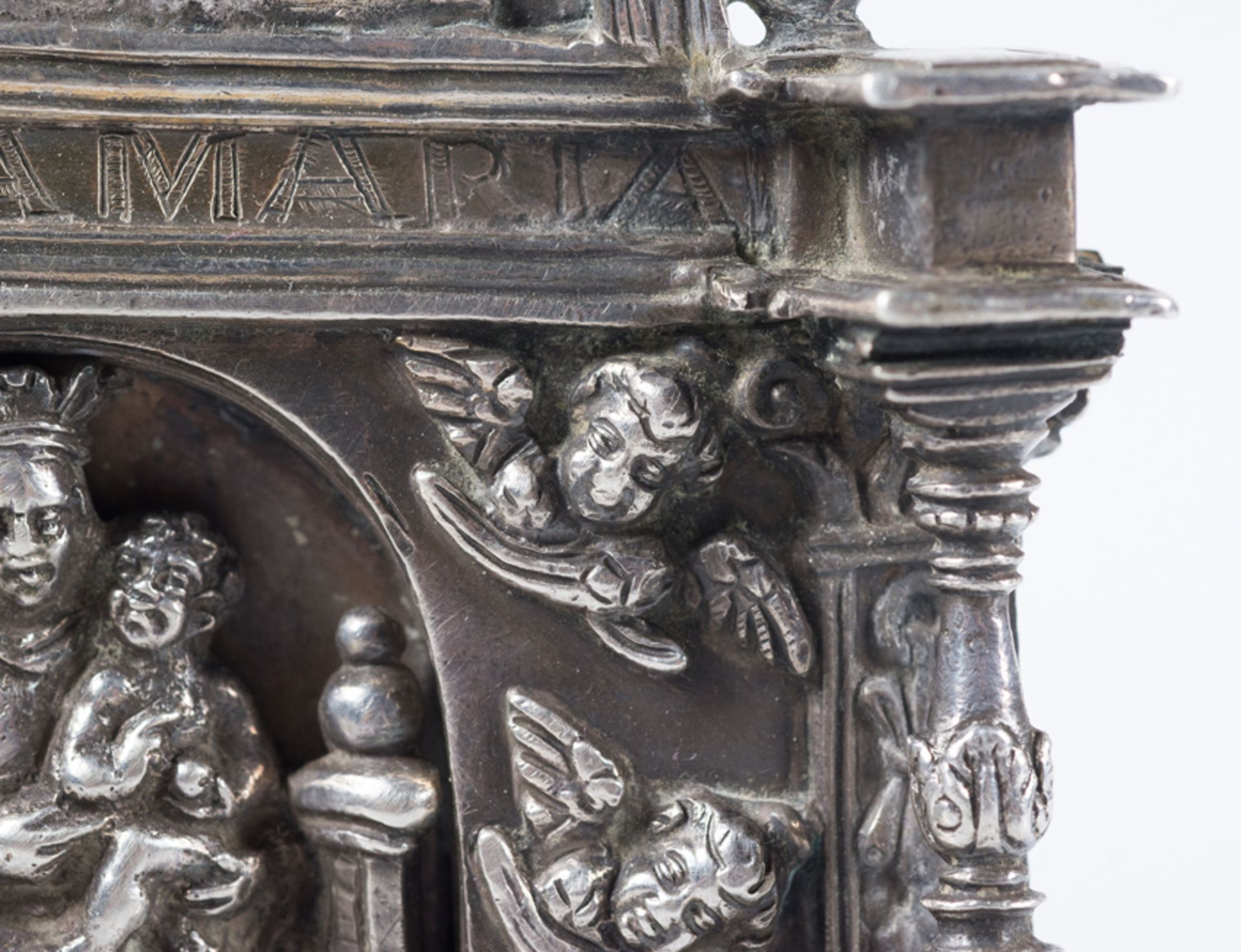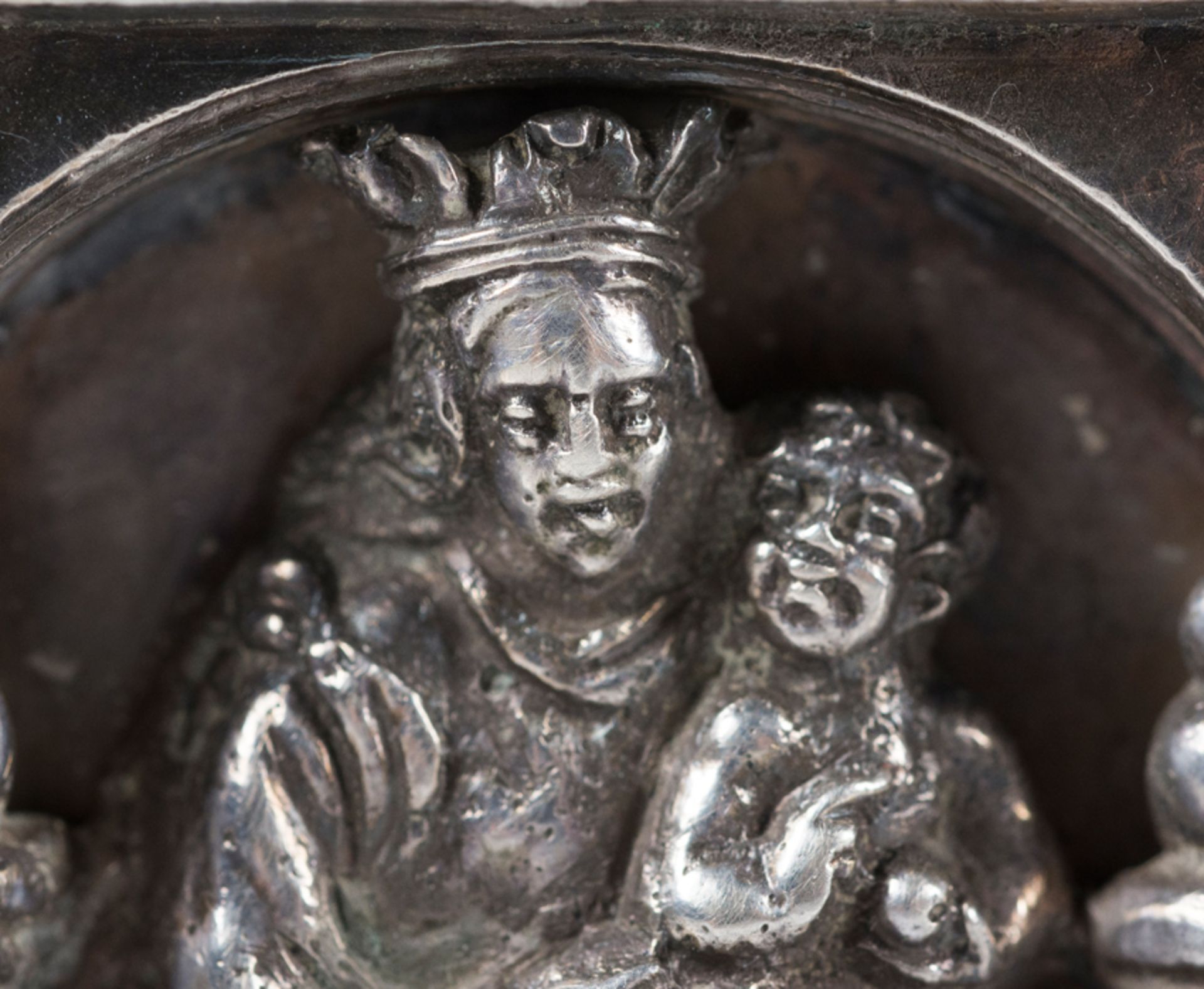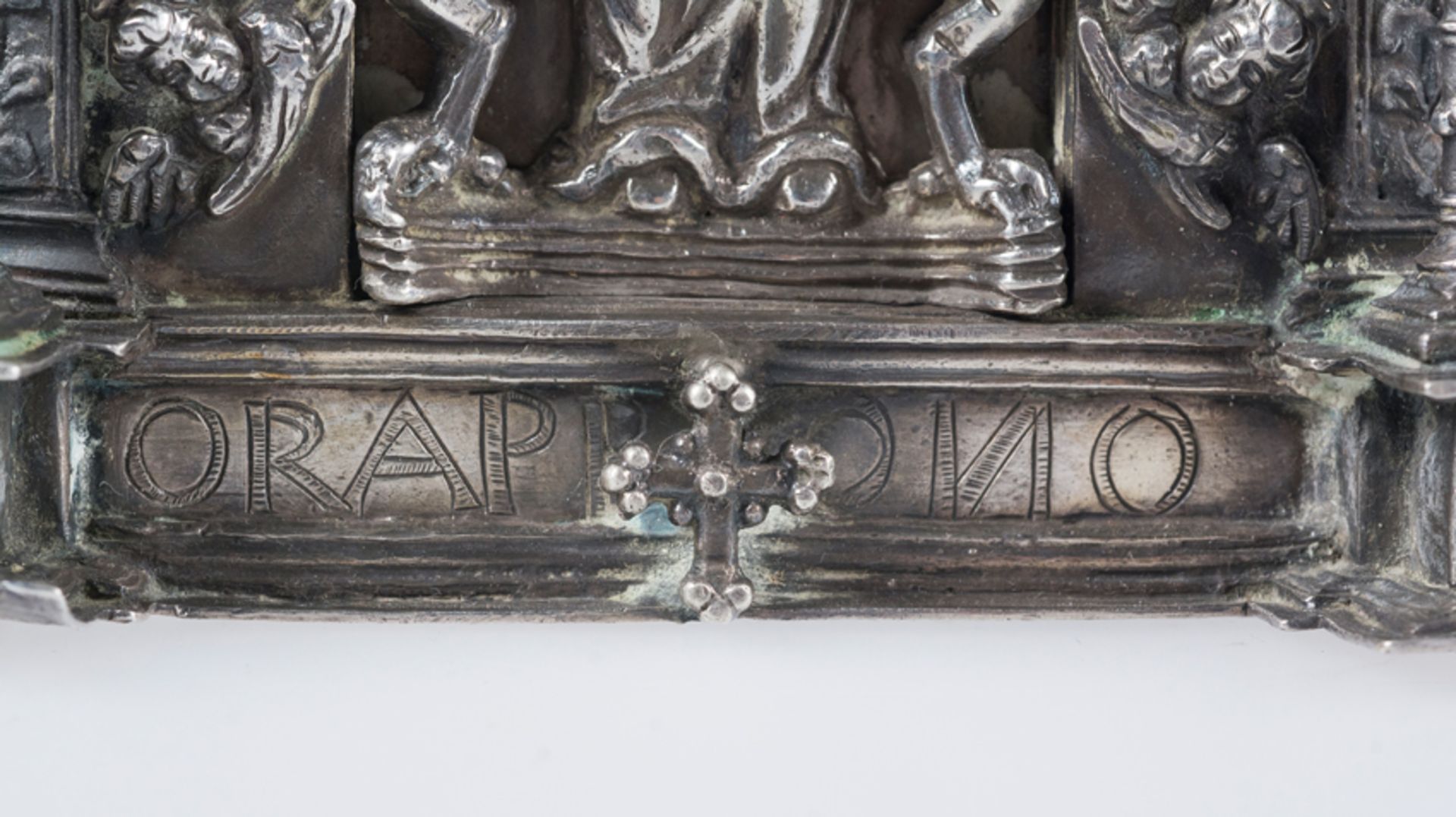30
Silver pax. With the silversmith Domingo Durango's mark (based in Daroca and active circa 1580)
In Millésime 23
13 x 11 x 5cm. WEIGHT: 321 G.
In the shape of an aedicule or small Doric order temple. The base is extended at the ends by two plinths on which two balustraded columns stand, supporting a small entablature on which a curved pediment rests.
On the pediment a crest is displayed based on scroll elements. The scene represented in the central section is the seated Madonna with the Child seated on her lap. The image is sheltered in a niche and is flanked by three cherubs on each side. On the pediment, God the Father gives blessing. There are two inscriptions on the shrine: on the entablature SANTA MARIA and on the base ORA PRONO (BIS) with a small cross in the centre.
There is a handle on the back that functions as a stand for placing the pax on the altar and for passing it from one worshipper to another.
It bears the silversmith's mark; O/DUR. This mark, according to the studies of Daroc silverware carried out by Fabián Mañas Ballestín, corresponds to the silversmith Domingo Durango, active around 1580 and with documented work in various locations such as San Martín del Río, Villahermosa del Campo, Báguena, Burbáguena, Lanzuela, Loscos, Lechago, Valdehorna and Villanueva de Jiloca.
One of the objects used for worship that has fallen into disuse is the pax. It is a small piece, which can be made of different materials, such as metal, ivory, ceramic, etc., with an image or signs in relief. In the most solemn celebrations, the pax was passed from one member of the congregation to another to be kissed in a mass for peace.
The origin of the pax dates back to the Middle Ages, but it was from the 15th century and especially in the 16th and 17th centuries that it reached its peak, its use declining at the end of the 19th century.
The first paxes were conceived with very elaborate Gothic architecture, derived from medieval reliquaries in the form of an aedicule. It was in the second quarter of the 16th century when the typological change in the pax took place, through the introduction of Renaissance silverware models and after the Council of Trent (1545) its iconographic repertoire was enriched.
From the beginning, these objects were conceived as small architectural pieces that contained a devotional image. Juan de Arfe describes the way to make a pax in his Varia Commesuracion: "Two parts make the top of a pax,
and one of them forms the seat,
setting itself towards the upper side,
and so that this seat is capable,
it is made with a stout base,
and the handle is very light so it goes
in such a way that it neither twists nor falls." Reference bibliography: - Sanz Serrano, María José. (1982). “Portapaces renacentistas del museo Lázaro Galdiano”. Goya: Revista de arte. Nº 167-168. pp. 258-270. - Xilocapedia. (21 de agosto de 2015). “Durango, Domingo (platero)”. https://xiloca.org/xilocapedia/index.php?title=Durango,_Domingo_(platero)
13 x 11 x 5cm. WEIGHT: 321 G.
In the shape of an aedicule or small Doric order temple. The base is extended at the ends by two plinths on which two balustraded columns stand, supporting a small entablature on which a curved pediment rests.
On the pediment a crest is displayed based on scroll elements. The scene represented in the central section is the seated Madonna with the Child seated on her lap. The image is sheltered in a niche and is flanked by three cherubs on each side. On the pediment, God the Father gives blessing. There are two inscriptions on the shrine: on the entablature SANTA MARIA and on the base ORA PRONO (BIS) with a small cross in the centre.
There is a handle on the back that functions as a stand for placing the pax on the altar and for passing it from one worshipper to another.
It bears the silversmith's mark; O/DUR. This mark, according to the studies of Daroc silverware carried out by Fabián Mañas Ballestín, corresponds to the silversmith Domingo Durango, active around 1580 and with documented work in various locations such as San Martín del Río, Villahermosa del Campo, Báguena, Burbáguena, Lanzuela, Loscos, Lechago, Valdehorna and Villanueva de Jiloca.
One of the objects used for worship that has fallen into disuse is the pax. It is a small piece, which can be made of different materials, such as metal, ivory, ceramic, etc., with an image or signs in relief. In the most solemn celebrations, the pax was passed from one member of the congregation to another to be kissed in a mass for peace.
The origin of the pax dates back to the Middle Ages, but it was from the 15th century and especially in the 16th and 17th centuries that it reached its peak, its use declining at the end of the 19th century.
The first paxes were conceived with very elaborate Gothic architecture, derived from medieval reliquaries in the form of an aedicule. It was in the second quarter of the 16th century when the typological change in the pax took place, through the introduction of Renaissance silverware models and after the Council of Trent (1545) its iconographic repertoire was enriched.
From the beginning, these objects were conceived as small architectural pieces that contained a devotional image. Juan de Arfe describes the way to make a pax in his Varia Commesuracion: "Two parts make the top of a pax,
and one of them forms the seat,
setting itself towards the upper side,
and so that this seat is capable,
it is made with a stout base,
and the handle is very light so it goes
in such a way that it neither twists nor falls." Reference bibliography: - Sanz Serrano, María José. (1982). “Portapaces renacentistas del museo Lázaro Galdiano”. Goya: Revista de arte. Nº 167-168. pp. 258-270. - Xilocapedia. (21 de agosto de 2015). “Durango, Domingo (platero)”. https://xiloca.org/xilocapedia/index.php?title=Durango,_Domingo_(platero)
Millésime 23
Auktionsdatum
Ort der Versteigerung
Generelle Versandinformationen vom Auktionshaus verfügbar
The purchase price includes the delivery of the lots in the venue of the auction. Transporting to other destinations is at the own risk of the client. The customer must contact "LST", to give the corresponding instructions for such transporting. "LST" is not responsible for the packaging or any accident incurred during transportation.
Wichtige Informationen
Millésime 2023. Paintings, sculptures and works of Art from 13th to 20th Century. 61 important lots of European and Viceregal Art.
A pair of castas paintings Attributed to Ramón Torres (active in Mexico, 1770 - 1790), A Divine Shepherdess by Miguel Cabrera (Antequera de Oaxaca, Mexico, 1715 / 1720 - Mexico, 1768) an Imposing pair of angels from Viceroyalty of Peru. 17th - 18th century, a 14th century Calvary from Byzantine or Venetian School, or the great collection of 16th century flemish and italian oil on copper, are just few examples.
AGB
CONDITIONS OF THE AUCTION:
I. REGISTRATION. To bid in the room customers must register at the beginning, filling out a form and picking a number that will identify them during the auction. Customers may be required to register in bank references or other guarantee system and if they do not prove the solvency "LST" will not accept bids and award the auction.
II. WRITTEN BIDS. "LST" will accept written bids, which will be formalized in the form provided by the room until the day before the auction. In such auctions, the room will bid in name of the client until the maximum stated in the offer and always at the lowest possible price. If there are two or more bids for the same amount, the one placed first will have the priority. Written bids received in advance, will have priority on the day of the auction.
III. TELEPHONE BIDS. "LST" will allow telephone bids, if interested people contact "LST" days before the auction providing personal data, ID card and the phone number which will be used by the staff of "LST" to call at the time of the auction. The buyer, within all the legal rights is making an offer for the asking price, when applies for telephone bid. "LST" will not take responsibility for any technical defects beyond its control, which may prevent to contact successfully the bidder during the auction.
IV. AUCTIONEER. The auction will be conducted by an auctioneer, director of the auction will be judge and arbitrator of it with full authority in its development, will award the lots to the highest bidder and is able to settle any controversy concerning lots sale, reject bids, divide lots or group them and remover objects from the room. Will be able to, if it is deemed suitable, not accept bids on the auction. His decision will be unappealable.
V. SALE OF LOTS. The lots are awarded to the highest bidder. Once the auctioneer blows the hammer, the buyer becomes responsible of the lot purchased, exempting "LST" of liability to for any damage and / or accidents that may occur. No refunds of lots.
VI. STARTING PRICE. The amount shown in the catalogue as the starting price for each lot will be, as a rule, the minimum selling price, except for exceptional cases where a reservation may be agreed upon with the seller or it set discretionary by the room.
VII. SCALE OF BIDS. The bids are set according to the following scale:
From 50.-€ to 200.-€…………………………………………..at 10.-€
From 200.-€ to 500.-€…………………………………… …25 in 25.-€
From 500.-€ to 1.000.-€………………………………..…..….50 in 50.-€
From 1.000.-€ to 2.000.-€………………………………..…100 in 100.-€
From 2.000.-€ to 5.000.-€……………………………….….250 in 250.-€
From 5.000.-€ to 10.000.-€…………………………………500 in 500.-€
From 10.000.-€ to 20.000.-€……………………………1.000 in 1.000.-€
From 20.000.-€ to 50.000.-€……………………………2.500 in 2.500.-€
From 50.000.-€ to 100.000.-€…………………………..5.000 in 5.000.-€
From 100.000.-€ to 100.000.-€………………………10.000 in 10.000.-€
From 200.000.-€ to 200.000.-€………………………25.000 in 25.000.-€
From 500.000.-€ to 500.000.-€………………………50.000 in 50.000.-€
VIII. RIGHT OF ADMISION. "LST" reserves the right to admission to the auction room and to reject, at its judgment, any purchase order, from clients whose solvency is not duly proved as well as not to sale auctions.
IX. SALE PRICES. The successful bidder of one or more lots must pay "LST" the final sale price achieves at auction, plus the 22 % plus 21% VAT on the commission, at total 26,62 % on Hammer Price.
X. CATALOG DATA. The catalogue data are obtained in order to careful research and advice, however, any responsibility is afforded about its accuracy. The lots will be auctioned in the state in which they are, not accepting any claims in restorations, breakage, damage, imperfections and, even description or numbering mistakes in the catalogue, in case of it, being the burden of the buyers to make sure before the auction that the description matches with their personal opinion about respective lot. The exhibition of the lots is intended to allow a perfect review and study of them.
XI. PAYMENT AND REMOVAL OF LOTS. Payment and removal of the lots will be held no later than five days following the auction. After this period expire without having the buyer removed the lot or lots purchases, it will accrue an expense of custody of 6 euros per day on each lot.
15 days after the auction without having the buyer paid and removes the sold lots, "LST" will inform the seller and there will begin judicial proceeding in order to obtain payment. The delay in payment by the purchaser of his/her sold lots will carry an interest increase at a rate of 1,5% per month.
XII. DELIVERY OF LOTS. The purchase price includes the delivery of the lots in the venue of the auction. Transporting to other destinations is at the own risk of the client. The customer must contact "LST", to give the corresponding instructions for such transporting. "LST" is not responsible for the packaging or any accident incurred during transportation.
XIII. RIGHT OF FIRT REFUSAL AND REPURCHASE. "LST" in order to article 38 of "Ley 16/1985 de 25 Junio del Patrimonio Histórico Español" (BOE. 155 June 29, 1985), will notify in advance to the Ministry of Culture, the content of their catalogues. Concerning the lots subject to the legislation referred to in the preceding paragraph, the Administration may exercise the rights of first refusal and repurchase according to the law. "LST" will watch over the protection of Artistic, Historical and Bibliographical Heritage of Spain. For customers out of European Community, a tax for export is required by the Administration.
XIV. VALUE ADDED TAX (I.V.A). This tax will be accrued on commissions of "LST" for buyers, using the rates prevailing on the date of the auction.
XV. DATA PROTECTION. In order to the "Ley 15/1999 de 13 de Diciembre, de Protección de Datos de Carácter Personal", the client authorize "LST", the inclusion of their data in a customer file, and for the promotion by "LST" of the objects at all times the rights of access, rectification or deletion of personal data by sending the appropriate request to the following address: LA SUITE SUBASTAS, C/ Conde Salvatierra, 8, 08006. Barcelona.
XVI. EXPRESS LEGAL JURISDICTION. These Conditions are governed by and interpreted in accordance with the rules of Spanish law. The mere act of participating in the auction as seller, buyer or bidder, implies acceptance of these Terms and Conditions.
Sales operations are understood to be held at the registered office of "LST", C/ Conde de Salvatierra, 8, 08006. Any dispute shall be taken to the competent courts of Barcelona, expressly waiving any other jurisdiction, in accordance with Article 55 of the "Ley de Enjuiciamiento Civil".
























